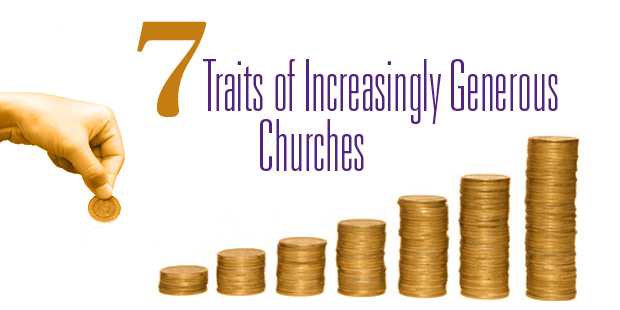
7 Traits of Increasingly Generous Churches
One of the key metrics of financial giving in a church is per member giving: What is the average giving per member or per attendee? Per member giving is often masked by fluctuations in attendance and membership. The most effective measure is to calculate the average giving per member.
Churches with increased giving per member have seven dominant characteristics. These seven traits are becoming even more important as Millennials enter in our churches in greater numbers.
- Increased emphasis on belonging to a group. Those members in a group, such as a small group or Sunday school class, give as much as six times more than those attending worship services alone. Take time to absorb the previous sentence. It’s a huge issue!
- Multiple giving venues. Per member giving increases as churches offer more giving venues. I recommend all churches provide these four venues at a minimum: offertory giving in the worship services; online giving; mailed offering envelopes to all members and givers; and automatic deductions from members’ bank accounts. I also recommend churches strongly consider kiosk giving and offertories in groups. I will elaborate more on these issues in a later post.
- Meaningful and motivating goals. Church members give more if they see the church has a goal that will make a meaningful difference. “Increasing total gifts by 10%” is not a meaningful goal. “Giving 10% more to advance the gospel in the 37201 zip code” is more meaningful.
- Explaining biblical giving in the new members’ class. New member classes should be an entry point for both information on and expectations of biblical church membership. Biblical giving should be a clear and unapologetic expectation of church membership.
- Willingness of leadership to talk about money. In the 1980s and 1990s, some pundits did surveys of unchurched persons that indicated they did not go to church because “all they talk about is money.” As a consequence, many church leaders stopped talking about money altogether. While it is possible to communicate financial stewardship in an overbearing manner, it is inexcusable for leaders to be silent about financial stewardship by Christians.
- Meaningful financial reporting. Many churches provide financial reporting that only a CPA or a CFO can understand. Church members need to be able to understand clearly how funds are given or spent.
- Transparent financial reporting. If church members sense that pertinent financial information is being withheld, they tend to give less or nothing at all. While that does not mean every financial statement provides endless details, it does indicate that church members will have a clear idea of how funds are given and spent.
There are reasons for optimism in church giving. Many churches are experiencing increases in both total giving as well as per member giving. And most of those churches exhibit the seven characteristics noted above.
Would you like to learn more about generosity for your church? Connect with an Auxano Navigator and start a conversation with our team.

Tags: Generous Churches, Resourcing, Thom Rainer












